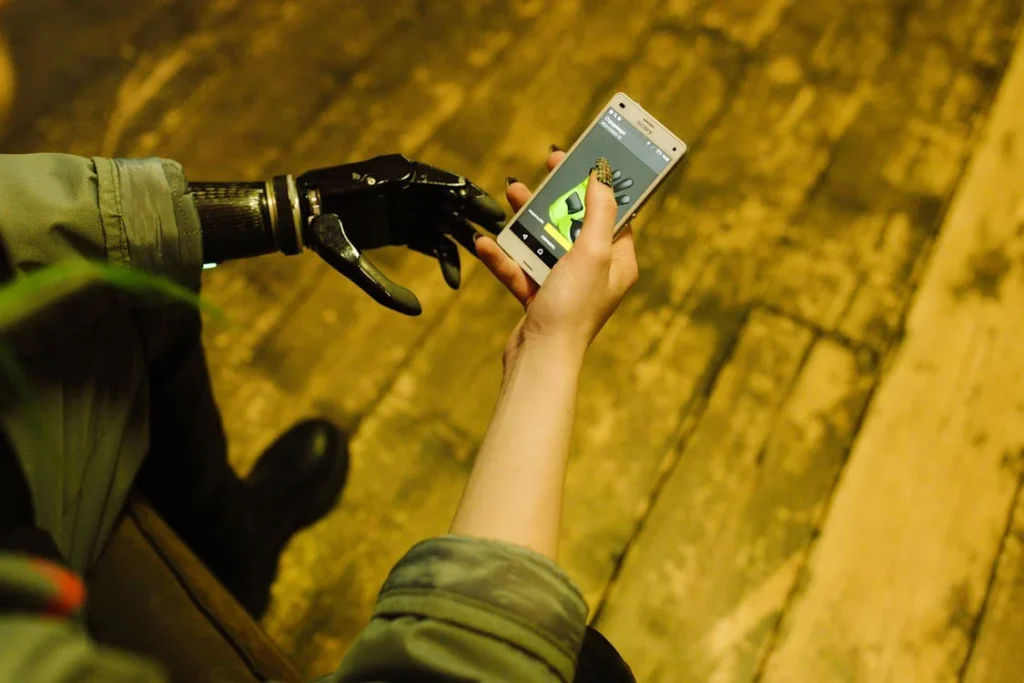Imagine being able to move your hand just by thinking about it. Not just move it—but hold a cup of tea gently, zip up your jacket, or pick up a coin from the floor. Now, imagine doing all that even if you’ve lost your hand.
This is the world AI is helping to build. A world where people with limb differences don’t just get a tool—they get a second chance to feel, move, and live life with freedom and confidence.
At RoboBionics, we’ve always believed that a prosthetic hand should feel like your own. It should know when you want to grip something. It should understand how hard or soft to hold it. That’s where artificial intelligence (AI) comes in.
AI is no longer just a buzzword or something out of science fiction. It’s quietly transforming the way modern prosthetics work, especially when it comes to predicting what the user wants to do (grip intent) and how tightly or softly they want to hold an object (pressure control). It’s like giving a prosthetic hand a brain that listens, learns, and responds just right.
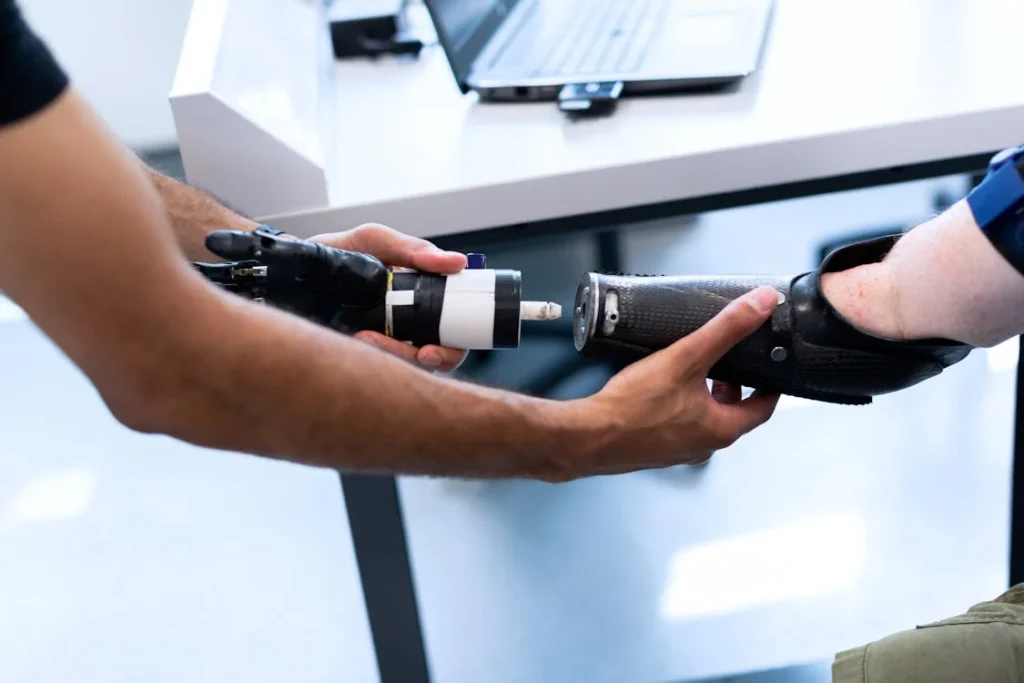
How AI Understands Grip Intent
What Is Grip Intent and Why It Matters
Before we talk about how AI works, let’s understand something very important—grip intent. Grip intent is simply the brain’s way of telling the hand, “Hey, I want to grab that.”
For someone with a natural hand, this happens automatically. You see a water bottle, and your hand just moves toward it. Your fingers shape themselves to hold it without even thinking.
But for someone using a bionic hand, this is a bit more complex. The hand doesn’t have nerves or a brain. So how does it know when to move, or what kind of grip to use? That’s where AI becomes the missing link between the brain and the bionic hand.
AI helps the hand understand what the user is trying to do and how they want to do it. It turns muscle signals, or myoelectric signals, into real actions.
These signals are tiny electric pulses that your muscles create when you try to move them. Even if someone has lost their hand, the muscles in their arm still send signals when they try to move their fingers. The AI picks up these signals and figures out the user’s intent.
How AI Learns Your Movements
Think of AI as a very attentive friend. It watches how your muscles behave when you try to do things—like pinch, grab, hold, or release. Over time, it starts recognizing patterns.
If you try to pick up a pen, your muscles fire in a certain way. The AI remembers that. If you try to squeeze a stress ball, it notices a different pattern. Bit by bit, it gets better at guessing what you’re trying to do.
At first, it might feel like the AI is learning to read your mind. But really, it’s just reading the language of your muscles. And it gets smarter the more you use it.
This kind of learning is called “machine learning.” It’s a part of AI where the system improves as it gets more data. The more you use your bionic hand, the better it becomes at understanding you. It’s like having a hand that adapts to you, instead of the other way around.
The Magic of Real-Time Response
What makes this all feel natural is how fast it happens. AI doesn’t just learn—it responds instantly. When you want to hold a spoon, the bionic hand doesn’t take seconds to think. It moves right away. That real-time reaction is what makes it feel less like a tool and more like a part of your body.
That’s also why grip intent powered by AI feels so special. It allows people to do everyday things without thinking twice. Imagine holding your child’s hand, tying your shoelaces, or writing with a pen—these are small things that mean the world. With AI, they become possible again.
At RoboBionics, our Grippy™ Bionic Hand uses this very kind of AI. We’ve trained it to be sensitive, smart, and quick. It works with your muscle signals and understands your intent better each day. It even lets you customize how you want it to respond, so your grip feels natural and safe.
When Technology Meets Emotion
AI in grip intent is not just about science—it’s about restoring something deeply human. It’s about giving people their freedom back.
When someone who’s lost a limb can now pour a cup of tea without help, or hug their loved ones properly, it’s not just a victory for technology—it’s a victory for dignity, confidence, and independence.
There’s an emotional side to this too. Many users tell us they start to feel like the bionic hand is truly theirs—not just something they wear. And that’s the whole point.
Technology should blend into life, not stand out. With AI, we are not just building smarter hands—we are building deeper connections.
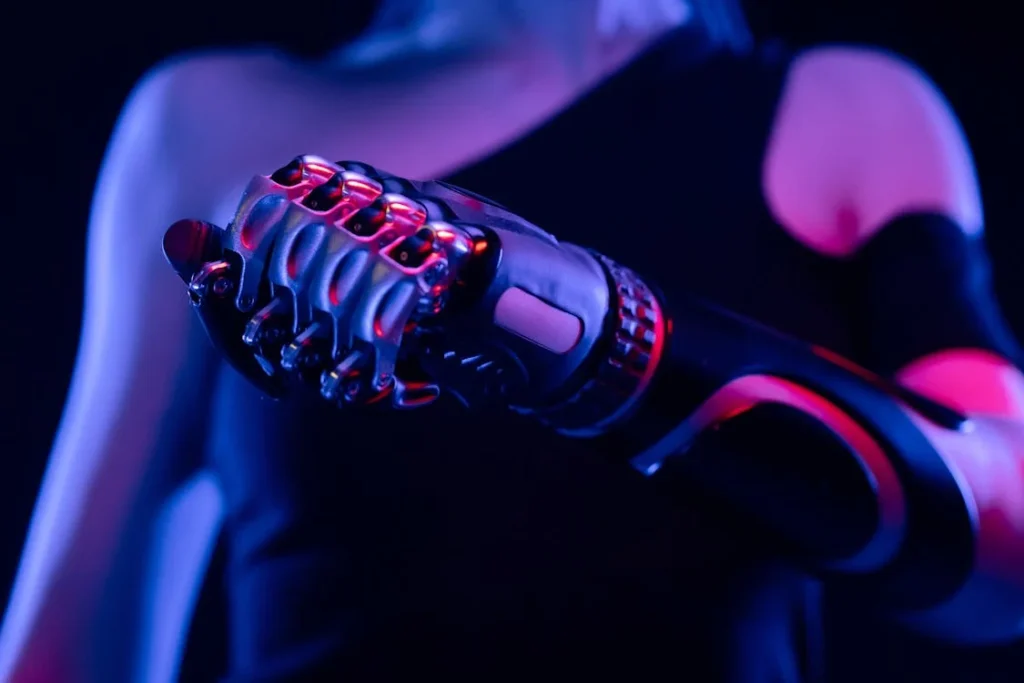
AI and Pressure Control: Holding Just Right
Why Pressure Control Is So Important
Imagine holding a ripe banana. You need just the right pressure—too soft and it slips out, too hard and you crush it. Now imagine tying your shoelaces or shaking someone’s hand. Each of these tasks needs a different kind of grip pressure.
That’s where pressure control comes in. For someone with a natural hand, the brain and nerves manage this perfectly without any effort. But for someone using a bionic hand, getting that same balance is not so simple.
If the hand can’t feel, it can’t adjust. And if it can’t adjust, it either grips too hard or not at all.
This is where AI becomes a game-changer. By combining AI with smart sensors and muscle signals, we can help the hand understand how tightly to hold something. It’s not just about grabbing—it’s about grabbing correctly. This means a person can hold a delicate object like a paper cup, or carry a heavy bag, using the same hand—with no damage and no fear.
How AI Balances Strength and Sensitivity
In the early days of prosthetics, hands could open and close, but that was about it. They didn’t know how strong they were being. People had to guess. That led to accidents—dropping things, breaking things, or not being able to hold something for long.
Now, with AI-driven pressure control, things have changed. Sensors in the hand track how much pressure is being applied. These sensors send data to the AI, which makes decisions in real time. It looks at the object’s resistance, how the user’s muscles are behaving, and what kind of grip is needed. Then it adjusts the grip strength automatically.
Let’s say you’re picking up a plastic cup. The sensors in the fingers notice the soft texture and light weight. The AI reads this and tells the motors inside the hand to use less power. If you pick up a thick book next, it tells the motors to use more. This all happens in a fraction of a second.
This is how AI creates balance. It gives users control, but also protects what they’re holding. It adds a layer of safety and trust that changes everything.
Personalization Through Learning
No two users are the same. Some people have stronger muscle signals. Others might have weaker ones. Some prefer a firm grip, others want a lighter touch. That’s why AI in pressure control must be personal. It should learn from the person using it, and adapt to their unique style.
Over time, the AI figures out how much force a user usually applies in different tasks. It watches for patterns and builds a model that reflects the user’s behavior. So the more someone uses their bionic hand, the more it feels like theirs. It doesn’t just copy human movement—it becomes part of the human experience.
This is something we focus on deeply at RoboBionics. Our patent-pending Sense of Touch™ technology brings together sensors, AI, and real-time feedback. It gives the user not just movement, but a real sense of control. They don’t need to guess anymore—they can feel confident that the hand is doing exactly what they need it to do.
From Feedback to Confidence
One of the biggest fears new users have is this: “What if I drop it?” Whether it’s a mobile phone or a hot cup of tea, that fear is real. Without pressure feedback, it’s hard to trust the hand completely.
AI changes that by giving the user a kind of artificial sense of touch. This feedback can come through small vibrations, sound, or even pressure in other parts of the limb. The user starts to know, even without looking, how much they’re gripping something. Over time, this builds trust. And with trust comes freedom.
People start doing things they once avoided. They stop being afraid. They stop holding back. That’s not just good for daily life—it’s good for mental health too. Confidence grows. People feel more in control of their bodies again.
We’ve seen this happen with our users. One young man told us how he started helping his mom in the kitchen again. Another started writing with a pen after years of avoiding it. These may sound like small steps, but for someone with a limb difference, they are huge victories. And it’s AI that makes them possible.
Real People, Real Stories
Behind every bionic hand is a human story. A father wanting to tie his daughter’s ponytail. A student hoping to hold a test tube in chemistry class. A grandmother wanting to water her plants.
These stories are the reason we do what we do. And they are also proof that pressure control isn’t just a technical feature—it’s a human need. It’s about helping people live fully, do everyday things with ease, and feel whole again.
AI gives us the tools to meet that need. It helps the hand listen, learn, and respond. And in doing so, it helps people reconnect with the world around them.
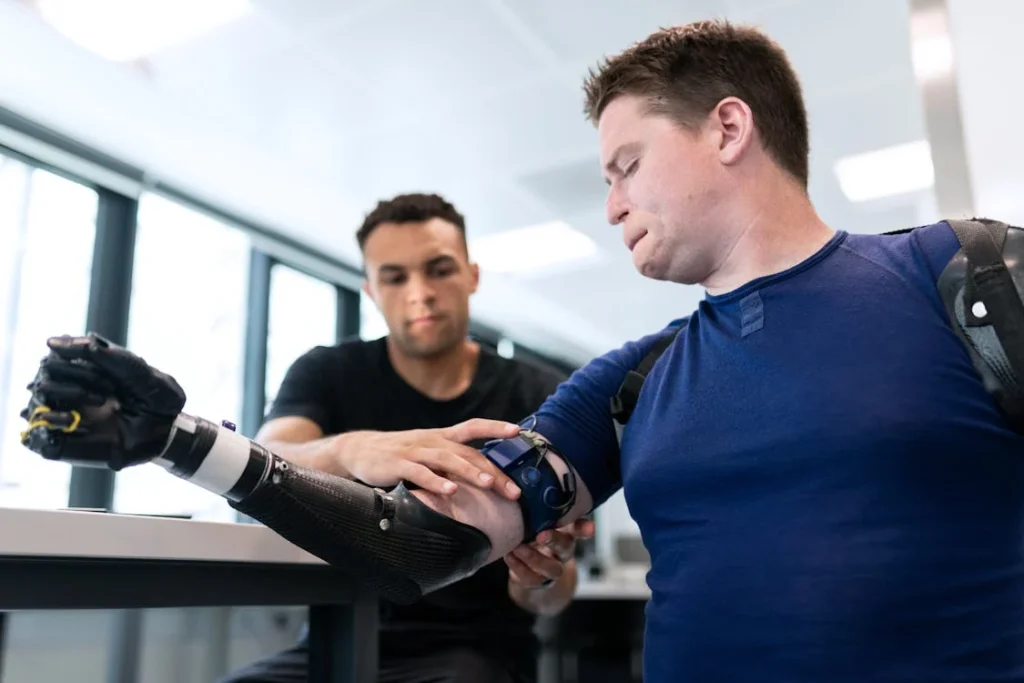
The Role of AI in Making Prosthetics Smarter Over Time
From Fixed to Flexible: The Shift in Prosthetic Intelligence
Not long ago, prosthetic hands were built with one basic rule—follow commands. You press a button or make a certain muscle move, and the hand opens or closes. That was it. It didn’t learn. It didn’t improve. It was the same on day 100 as it was on day 1.
Now, thanks to AI, all that has changed. Today’s advanced prosthetic hands are not just tools. They are learning systems. They grow and evolve with their users. The more you use them, the more they understand you. That’s the magic of AI in motion.
With every movement, the hand collects data—how you tried to grip, how your muscles fired, how much force was used, what kind of object you were interacting with. AI takes all of this and starts building a model of you. A model that reflects your unique movement style, strength, and preferences.
This shift from fixed to flexible design means no two AI-powered prosthetics behave exactly the same. They are tailored—not just in shape or fit, but in behavior. They don’t just act smart; they become smart for you.
Real-World Training, Real-World Results
AI doesn’t just learn in a lab. It learns in real life. As users go through daily activities—brushing teeth, making tea, tying shoelaces—the AI watches, listens, and adapts. This kind of learning is called real-world training.
Let’s say you like to hold your coffee mug a certain way. After a few days, the AI notices how you angle your wrist, how tight your grip is, and how long you hold it. The next time you reach for that mug, the hand responds faster and more accurately. You don’t have to think about it. It just works.
This creates a smoother, more natural experience. The bionic hand starts to feel less like a machine and more like an extension of you. That kind of comfort takes time, but with AI, it gets better every single day.
And the best part? You don’t have to teach it on purpose. You just live your life, and the hand learns along the way.
Fewer Mistakes, More Trust
Every prosthetic user has faced it—the awkward drop, the missed grab, the too-tight squeeze. These moments are frustrating. They make you hesitate. They make you doubt.
AI helps reduce those moments by learning from past mistakes. If you dropped your phone because the hand didn’t grip properly, the AI remembers that. It adjusts its model to avoid making the same mistake again. If you squeezed too hard on a paper cup, it learns to soften its grip next time.
This constant learning builds trust. And trust is everything. It means users stop second-guessing. They move more freely. They try new things. They feel safer and more in control.
That trust also leads to emotional healing. Many people with limb loss go through long periods of grief, anxiety, and frustration. When the prosthetic hand starts to respond correctly—when it starts to “get it”—something changes inside. That sense of loss slowly gives way to a sense of wholeness.
Updates and Upgrades: AI That Grows With You
Unlike old prosthetic models that stayed the same forever, AI-powered hands can be updated. At RoboBionics, we design our systems to grow. This means we can improve the AI even after the hand has been fitted.
Through software updates, we add new features, fix small bugs, and fine-tune the AI to work even better. That means your prosthetic hand stays up to date with the latest advancements—without the need for new hardware.
This future-ready approach is what makes AI so exciting. It’s not just about what the hand can do today. It’s about what it can do tomorrow, and the day after that. And it gives users something priceless—hope.
They know their journey is still moving forward. That their hand will keep learning. That they’re not alone in figuring it all out.
Bringing It All Together at RoboBionics
At RoboBionics, we’ve poured years of research into understanding how AI can make prosthetics truly empowering. We’ve worked with real users, listened to their feedback, and built features that reflect real needs—not just cool tech.
Our Grippy™ Bionic Hand is a result of this commitment. It combines AI with muscle signal processing, smart pressure control, and our unique Sense of Touch™ technology. It’s built not just to move, but to understand. It’s designed to adapt to each user’s body, mind, and way of life.
More importantly, we’ve made it affordable. While most imported bionic hands cost over ₹10 lakh, Grippy™ is proudly made in India and priced between ₹2.15 to ₹3 lakh. We believe that world-class technology should be within reach for everyone—not just the privileged few.
That’s why we’re not just building prosthetics. We’re building partnerships. We work closely with prosthetic centers, rehabilitation experts, and most importantly—users. Every hand we deliver is a promise of better days ahead.
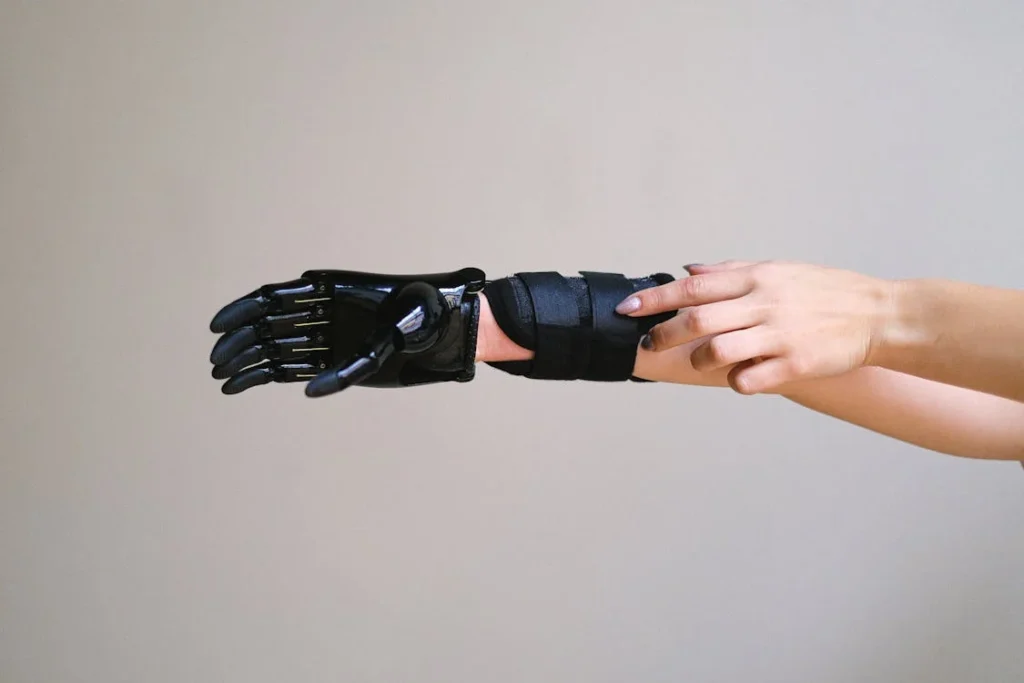
Challenges and Opportunities in Using AI for Prosthetics
The Challenges We Face Today
While AI has brought incredible advances to prosthetics, it hasn’t been an easy road. There are still real-world challenges that must be solved to make these hands better, faster, and easier for everyone to use.
One of the biggest challenges is signal clarity. The muscle signals that control a prosthetic hand are often weak, especially for people who have had an amputation for a long time.
Over time, the remaining muscles can shrink or change, making it harder for sensors to pick up a clear signal. If the AI gets a blurry signal, it has a harder time understanding what the user is trying to do. It’s like trying to hear someone whispering in a noisy room.
Another challenge is the sheer variety of human movement. Every person grips things differently. Some people move fast, others slowly. Some use strong signals, others use soft ones.
Teaching an AI system to recognize all these differences—and respond perfectly every time—is not easy. It takes massive amounts of data, smart software, and constant fine-tuning.
Then there’s the challenge of keeping the prosthetic light, affordable, and durable. Adding more sensors, more computing power, and more features can increase the weight and cost.
But at RoboBionics, we are committed to keeping our products accessible. We work hard to find the right balance—using smart, local engineering to build bionic hands that are both powerful and practical.
Another challenge lies in training and onboarding. Even the smartest prosthetic hand needs some time to get to know its user—and the user needs time to get comfortable with the hand.
That’s why we offer a detailed onboarding process and support network. We make sure that every user knows how to use, adjust, and grow with their bionic hand. We also guide therapists and families so the user never feels alone in this journey.
The Human Touch Behind the Technology
Despite the tech, this is still a very human experience. AI can’t do it all on its own. It needs designers, engineers, therapists, and users working together. Each hand we build is the result of many hours of teamwork, testing, and care.
At RoboBionics, we listen carefully to every story. We ask our users how the hand feels, what it can do better, what they wish it could do. That feedback is gold. It shapes the AI. It helps us decide which features to improve, which motions to make smoother, and how to offer more value with each update.
Some of our best ideas have come from the people who use our hands every day. One user suggested a better way to grip cooking utensils. Another asked for more grip strength for carrying bags. We turned those ideas into real updates that made the AI smarter. This is not just product development—it’s co-creation.
The Huge Opportunity Ahead
Here’s the exciting part: we’re still just getting started. AI has already transformed prosthetic hands. But its full potential is even greater.
In the near future, we expect AI to not only react to muscle signals but also predict what the user wants to do next. Imagine a hand that senses your intent even before you fully move a muscle. That kind of predictive power could make bionic hands feel completely natural, like second nature.
We’re also exploring deeper forms of feedback. Right now, Sense of Touch™ lets users feel some pressure. But what if they could feel temperature, texture, or even pain? These sensations could be recreated using haptic signals, making the hand even more lifelike.
AI could also help users with more complex tasks. Instead of just grabbing objects, imagine a hand that helps you type, swipe on your phone, or use a pen with complete control. These tasks need ultra-fine movements, which AI can learn through advanced motion modeling.
Even more exciting is the idea of shared learning. If one user’s AI learns something useful—like how to grip a delicate object—that learning could be shared with other users. This way, everyone benefits. The whole community of users grows smarter together.
We’re also working on AI that adjusts itself not just over days, but throughout the day. If you’re tired, if your muscles are sore, if the weather is hot—your signals might change. The AI will notice and adapt in real time, keeping the experience smooth no matter what.
And finally, there’s the big dream—using AI to reconnect the brain directly with the hand. Brain-computer interfaces (BCIs) are already being studied in labs around the world. Someday, AI could help decode brain signals directly, letting users move their prosthetic hand just by thinking. That might sound like science fiction, but it’s coming closer every year.
Why India Matters in This Journey
India has a unique role to play in the future of AI-powered prosthetics. We have millions of people who need affordable, high-quality solutions. We also have a growing tech ecosystem, brilliant engineers, and a spirit of innovation.
At RoboBionics, we’re proud to be part of this movement. We build 60 of the 64 components of our Grippy™ Bionic Hand right here in India. That’s not just about saving cost—it’s about creating world-class tech for our own people, designed by minds that understand local needs.
We believe that AI in prosthetics should not be a luxury. It should be available to every child who lost a hand in an accident, every soldier injured in duty, every worker who faced a life-changing event. With the right support, AI can give them all a chance to live fully again.
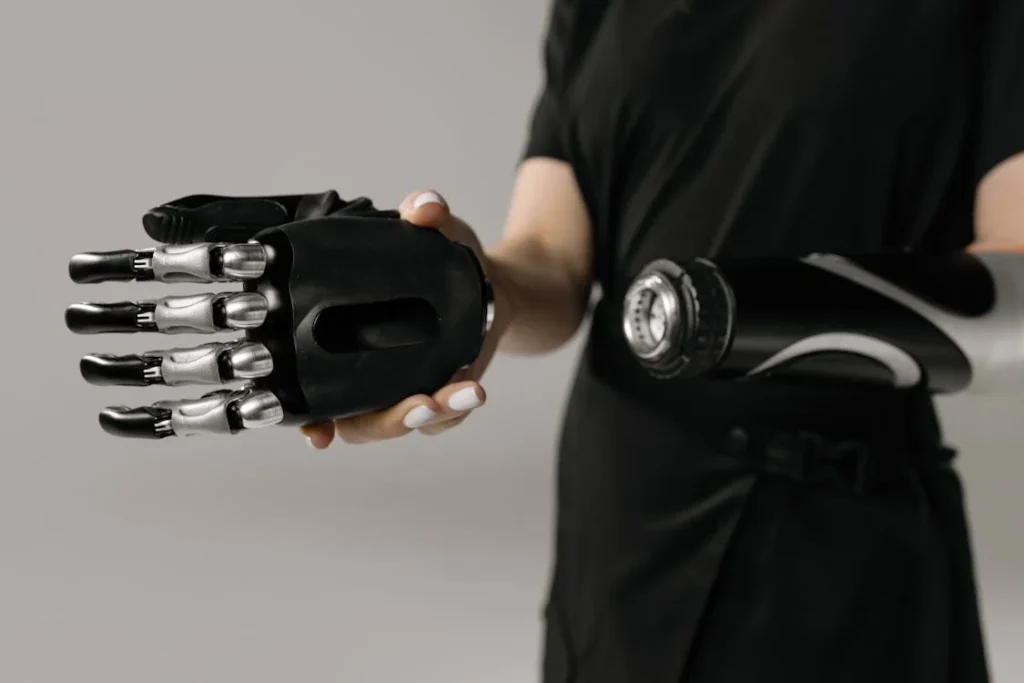
AI and Emotional Intelligence in Bionic Hands
Moving Beyond Motion: Understanding the User’s State of Mind
Until now, we’ve talked about how AI in prosthetic hands reads muscle signals, predicts intent, and controls grip strength. But there’s another powerful area that’s just beginning to emerge—AI’s ability to understand how the user feels.
Think about this. Human hands don’t just act on commands. They reflect emotions. We squeeze tightly when we’re nervous. We hold softly when we’re calm. We might drop something if we’re distracted or fidget when we’re bored. Our hands are deeply connected to our emotional state.
AI in prosthetics is now starting to bridge that gap. It’s learning not just what users do, but how they feel when they do it. And this emotional context is changing the way bionic hands respond.
For example, if a user is anxious, their muscle signals may become erratic. Traditional systems might misread those signals and cause the hand to jitter or grip too hard. But with emotional-aware AI, the system learns to detect those subtle changes and gently compensate—perhaps by slowing down the response time or stabilizing grip pressure.
This might sound like a small detail, but it makes a world of difference. Because when the hand adjusts to your mood, it doesn’t feel robotic—it feels like it gets you.
Personal Comfort, Not Just Performance
When we talk about AI in prosthetics, we often focus on performance—how fast it reacts, how strong it grips, how precisely it moves. But equally important is how the user feels using it. Is it comforting? Is it stressful? Does it give peace of mind, or does it feel like something they constantly have to manage?
This is where emotionally intelligent AI shines. It focuses on comfort and emotional alignment. If a user tends to get frustrated during certain activities—say buttoning a shirt—the AI can learn to slow down responses, offer gentler haptic feedback, or even suggest taking a break.
Eventually, these systems could connect to wearables that measure heart rate, skin temperature, or other signals of stress. Imagine your bionic hand automatically adjusting when you’re tired, tense, or relaxed. It becomes not just an assistant, but a silent partner that watches out for your wellbeing.
We’re exploring these possibilities at RoboBionics because we believe prosthetic tech should support the whole person—not just the physical side, but the emotional side too.
Rebuilding Identity, One Gesture at a Time
There’s a quiet, often unspoken part of losing a limb that AI is uniquely positioned to help with: identity.
Hands are more than tools. They’re part of how we express ourselves. We wave, we point, we clap, we gesture when we talk. Many people with limb loss say they miss not just function—but the ability to communicate with their hands.
By understanding emotional tone and user behavior, AI is helping bring this back. Some bionic systems now allow for pre-set gestures or “emotive modes”—like a gentle wave, a thumbs-up, or even a light touch that mimics a reassuring pat.
These gestures may seem small, but they carry deep meaning. They help users reconnect with their personalities. They allow them to be seen again, not just as someone with a prosthetic, but as a full person with feelings, style, and presence.
We’ve seen users smile when they can shake hands at a job interview, or pat a friend on the back with confidence. That’s not just movement—that’s identity, restored.
The Future of Empathetic Prosthetics
As AI evolves, we see a future where prosthetic hands don’t just obey—they care. Where your bionic hand doesn’t just hold a pencil, but knows when you’re nervous before a test and steadies your grip. Where it can detect signs of emotional distress and offer a gentle vibration of comfort, like a reassuring tap.
This kind of technology doesn’t replace human connection—but it supports it. It helps people feel safe in their bodies, no matter what they’ve been through.
At RoboBionics, we believe this is the next frontier. Not just smart prosthetics, but empathetic ones. Systems that serve with dignity. Hands that heal—not just with function, but with feeling.
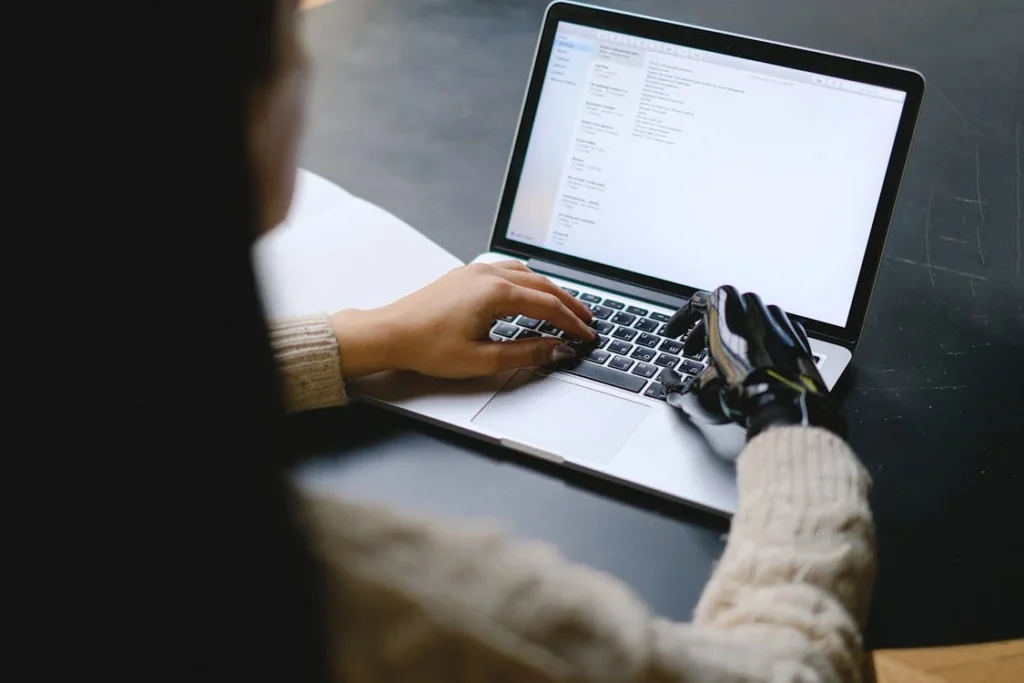
Designing for All: How AI Adapts to Every User, Every Lifestyle
One Size Doesn’t Fit All—and AI Makes Sure of It
Every person is different. A child playing in the park, a teacher holding chalk, a tailor working with fine fabric, and a construction worker lifting bricks all use their hands in very different ways. Their muscle signals vary. Their daily needs are miles apart. Their lifestyles shape their movement patterns—and this is where old prosthetics fell short.
Traditional designs often tried to make a single type of hand work for everyone. But with AI, we now have the power to change that. AI doesn’t force users to adapt to the hand—it helps the hand adapt to the person.
At RoboBionics, we see this every day. Our users come from all walks of life. Some are athletes. Some are artists. Some are school children. The way they use their bionic hand is completely unique. And our AI makes sure that the hand learns to suit them, not the other way around.
That means no more stiff, generic movements. No more one-grip-fits-all. With AI, a child can learn to grip a pencil without pressing too hard. A cook can stir soup without spilling. A student can switch from writing to typing with ease—all because the AI molds itself to their rhythm.
Age Is Just a Number, but Needs Are Real
Children and older adults are two groups that often get left out in high-tech design. Devices are usually made for average adults. But prosthetics must be more thoughtful, because limb loss doesn’t discriminate.
Children, for example, have fast-changing bodies and fast-changing minds. Their muscle strength evolves. Their coordination improves rapidly. AI systems designed for them need to be flexible, forgiving, and fun to use. That’s why we focus on gamified training and learning-based grip modes—so kids enjoy using their prosthetic hand, not dread it.
AI makes it possible to design bionic hands that grow smarter with the child. It adjusts to their growing muscles and changes in how they play or learn. And because it’s constantly learning, the child doesn’t have to relearn every time they grow. The hand keeps up.
Older adults, on the other hand, may have weaker signals, slower reactions, or certain limitations in movement. AI helps make their experience smoother and less tiring. It reduces the number of failed attempts, allows more predictable behavior, and compensates when muscle signals fluctuate due to age, fatigue, or illness.
This level of support builds confidence. It allows users of all ages to feel safe, understood, and respected by their prosthetic hand.
Cultural and Lifestyle Sensitivity
AI also helps prosthetic hands adapt to different cultural and lifestyle contexts. For example, eating with your hands is common in India. Folding clothes, carrying tiffins, or lighting a diya—all involve hand movements that are deeply rooted in tradition. A prosthetic hand should know how to support those.
Our AI systems are trained with local tasks in mind. We take input from real Indian users, in real homes, doing everyday things. The hand learns what you do, not what someone in a lab in another country does. Whether it’s holding a steel tumbler or gripping a scooter handle, our systems learn those actions through continuous use.
This kind of cultural understanding makes the technology feel familiar, not foreign. It blends into life instead of standing out.
Gender-Aware Grip Patterns and Design
Men and women often use their hands differently—not just in strength, but in motion, technique, and touch. AI can notice these small but important differences and adjust the grip force, hand speed, or sensitivity accordingly.
For example, someone doing embroidery needs a delicate, precise grip that doesn’t fatigue the hand. A factory worker might need more sustained strength over longer periods. AI customizes the prosthetic behavior so the user doesn’t have to think too much or adjust their own behavior. It does the heavy lifting of personalization.
We’re also paying attention to things like wrist angles for jewelry wearers, or how to handle light fabric during saree folding. These aren’t “standard tasks,” but for many, they are daily needs. AI allows prosthetic technology to become as diverse as the people using it.
Making Inclusion the Norm, Not the Exception
Ultimately, AI in prosthetics is doing something bigger than just improving grip. It’s making the world more inclusive. It’s saying, “Your life, your needs, your ways of doing things—they matter.”
It helps create prosthetic hands that aren’t just functional, but deeply familiar. Hands that move how you move, adjust to your pace, and understand your everyday reality. That’s not just tech innovation—it’s human dignity.
And it’s only the beginning.
Conclusion
AI is not just changing how prosthetic hands move—it’s changing what they mean. It’s turning tools into companions, responses into relationships, and simple motion into emotional freedom. At RoboBionics, we believe that every person deserves a hand that doesn’t just function but feels right. A hand that learns with you, understands you, and adapts to your unique life.
From predicting grip intent to fine-tuning pressure, from adjusting to your mood to fitting your lifestyle—AI is making bionic hands truly human again. And most importantly, it’s making advanced prosthetics more accessible, more personal, and more empowering.
Because when technology listens with empathy and learns with love, it doesn’t just change movement. It changes lives.
Ready to feel the future? Book a free demo and experience Grippy™ for yourself.



